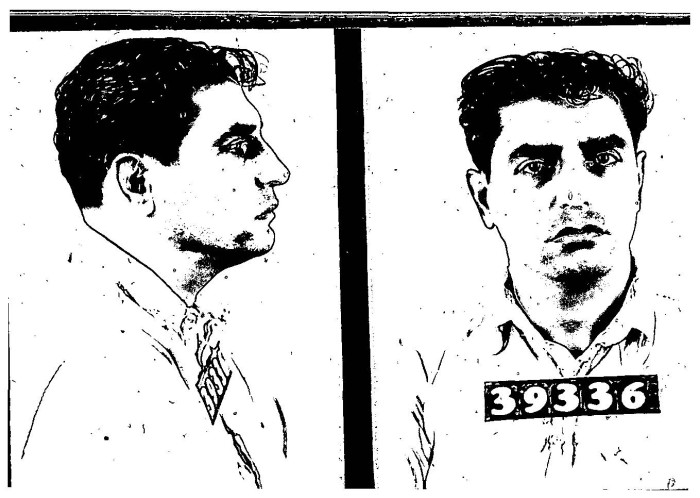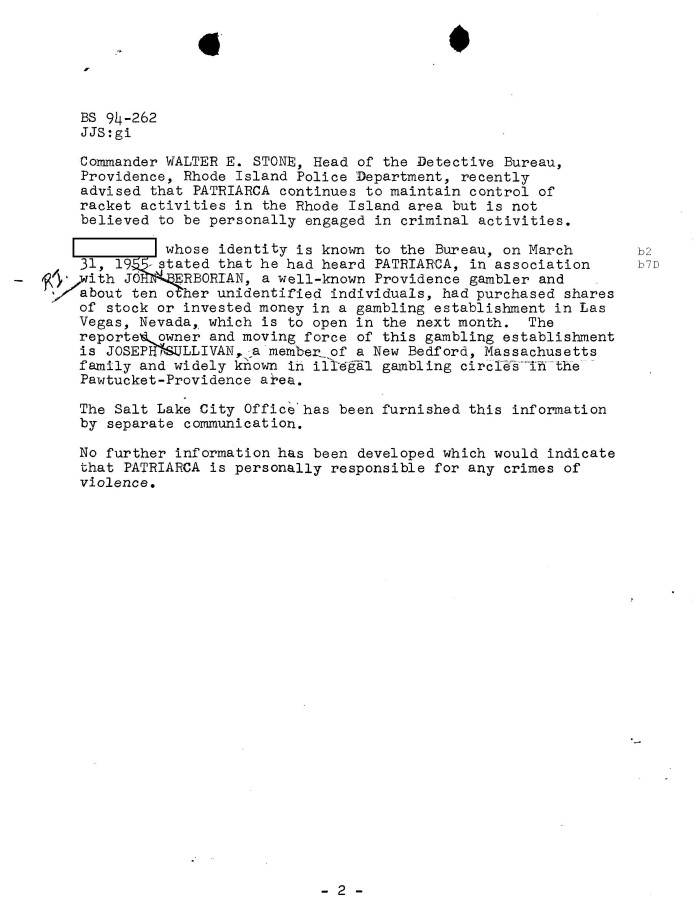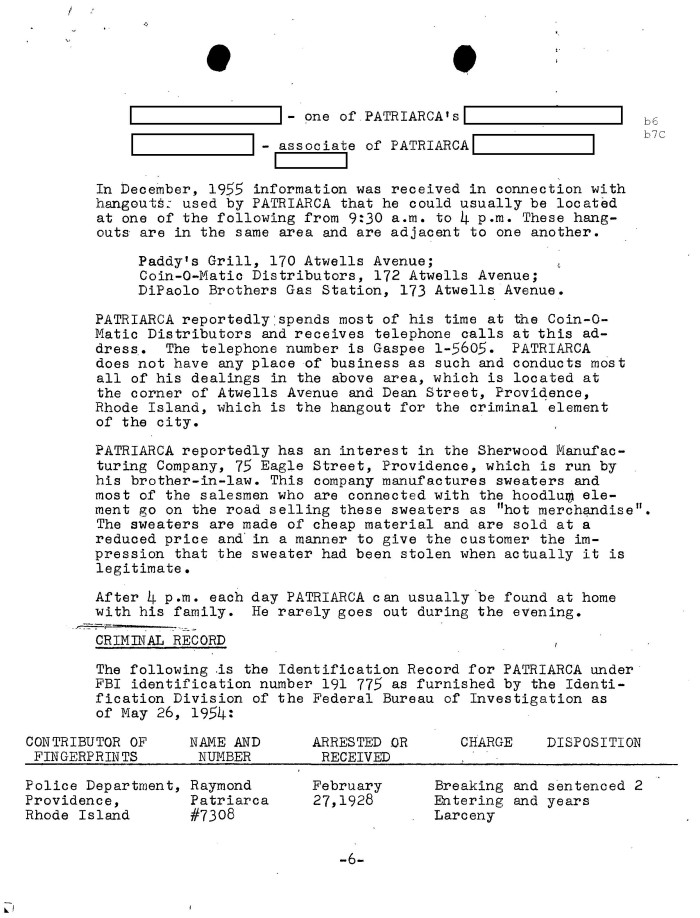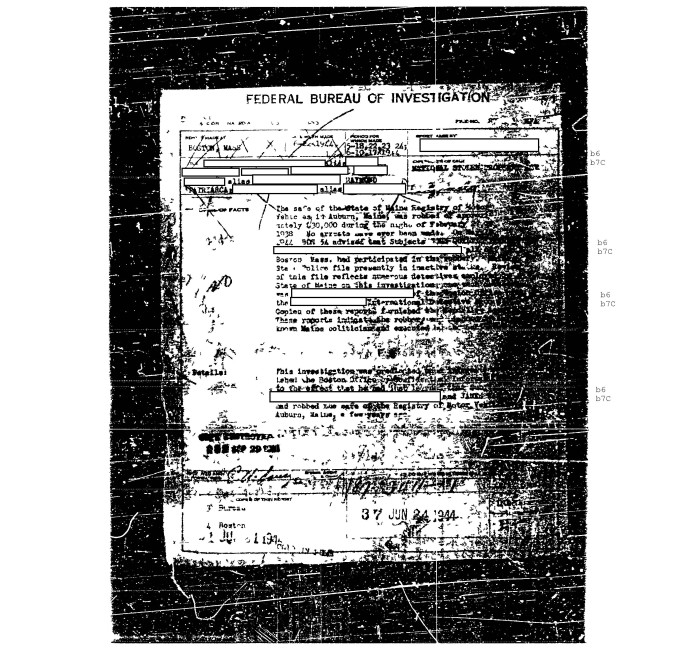Law Enforcement Experts Weigh in on The Patriarca Papers’ Entry 1
Monday, August 03, 2015
This week marks the release of the first group of papers of the FBI files of Raymond Patriarca, the head of the New England organized crime for nearly 40 years. Leading law enforcement experts breakdown the importance and learnings from these document - none of these top cops had ever seen these documents before.
“Patriarca was the most powerful organized crime figure in New England when he was the boss. He was feared and respected by the criminal element. Even though the Angiulo crime family had a stranglehold on Boston, they learned not to challenge Patriarca and would strive to remain in good standing with him,” said Tom Foley former Superintendent of the Massachusetts State Police.
GET THE LATEST BREAKING NEWS HERE -- SIGN UP FOR GOLOCAL FREE DAILY EBLAST
“I’m not at all surprised in reading these records. It begins to depict the classic pattern of how common criminals come together and form self-perpetuating conspiracies to wring profits from society by any means – legal or illegally,” said veteran organized crime fighter and presently Chief of Police for South Kingston, Vincent Vespia, “It cannot be disputed that Patriarca took the leadership role in the New England faction of what later became know in 1957 as La Cosa Nostra when Joe Valachi testified before Congress.”
Certainly, the FBI seemed behind law enforcement leaders like Rhode Island’s legendary Walter Stone, who in the early 1950’s was a Providence Police investigator and aggressively pursued Patriarca.
But was the FBI’s enthusiasm muted for other reasons?
“Rank and file FBI agents in New England certainly were attuned to the threat the mob - but was J. Edgar Hoover for whatever reason putting the brakes on focusing on the mob? While stories circulate as to why -- rumors of his sexual preference or that he was an African American -- and therefore was a blackmail target has been adequately established. In any event his lack of enthusiasm dampened the focus on the mob since agents were possibly concerned about personal advancement or the lack of resources until his (Hoover’s) retirement,” said former Rhode Island Attorney General Arlene Violet.
Transformation in the 1950s
Similarly, former Rhode Island State Police Superintendent Brendan Doherty points out that organized crime was in many ways being led by former young bootleggers.
“The reports are dated in the mid 1950’s which was an interesting time in organized crime in this country. Prohibition was repealed in 1933 and many of the younger gangsters that engaged in bootlegging through that era were older now and trying to take the money they made from ill-gotten goods and parlay it in to ostensibly legitimate business," said Doherty. "Raymond established the Coin-o-Matic.”
The pace of the number of memos filed by FBI agents was sparse in the early 1950’s.
“In the 50’s the awareness of the presence of the mob was just dawning on law enforcement. Leaders like Walter Stone who was then a Providence cop was laser-focused on Mr. Patriarca, so he was ahead of the curve. Wiretaps were not in vogue,” said Violet.
“Even these initial two documents that you have obtained strongly indicate that organized crime (OC) was fast becoming an illegal cartel. How could one not come to that conclusion? But as a result, in my opinion, of Valachi’s testimony and the 1957 Appalachia conclave in Binghamton, N.Y. it had to be acknowledged by all that OC cartels did exist. The Director of what was known as the Federal Bureau of Narcotics that predated today’s DEA was Harry Asslenger. He was an early advocate of the existence of international criminal conspiracies involving organized groups but received little or no support to his position. Too bad he was right,” said Vespia.
As the FBI started to pay attention, Congress also began hearings and investigations.
"And as the reports indicate that a few years prior to what Patriarca was described before Senator Kefauver's Crime Committee as “The King of the Rackets in Providence”. It’s also obvious that during that period of time when 'top hoodlums' would have liked to fly under the public eye, Raymond Patriarca’s nemesis was Chief Inspector Walter E. Stone of the Providence Police who later became the legendary Colonel of the Rhode Island State Police," said Doherty, who worker under Stone.
Related Slideshow: Patriarca Papers - Entry 1
Welcome to the first entry of the official Federal Bureau of Investigation file on Raymond Patriarca, the reputed head of New England Crime.
Related Articles
- Glossary of The Patriarca Papers Terms
- The Patriarca Papers Experts
- GoLocalTV: Previewing Section 1 of the Patriarca Papers
- The Patriarca Papers - FBI Files of the Boss of the New England Crime Family
- Was Federal Hill Safer When Raymond Patriarca Was in Charge?

























































































